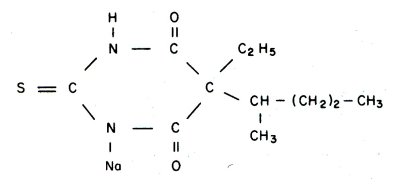Thiopentone
Uses
- Induction of anaesthesia
- Management of status epilepticus
- Cerebral protection
Chemical
A thiobarbiturate

Presentation
As an hygroscopic yellow powder, containing thiopentone sodium and 6% sodium carbonate stored in an atmosphere of nitrogen. The drug is reconsituted in water to give a 2.5% solution with a pH of 10.8 and a pKa of 7.6 which is stable for 24-48hrs.
Main Actions
Hypnotic and anticonvulsant
Mode of action
Barbiturates are thought to act mainly at synapses, depressing post-synaptic sensitivity to neurotransmitters and also be impairing pre-synaptic neurotransmitter release. Multi-synaptic pathways are depressed preferentially, particularly those of the reticular ativating system.
Route of administration / Dose
The dose is 2-7mg/kg by iv injection and acts within one arm/brain circulation, lasting 5-15 minutes. Thiopentone may be administered rectally in a dose of 1g/22kg body weight when it acts within 15 mins.
Effects
CVS
CO is reduced by 20% and there is a small reduction in SVR
Resp
Thiopentone is a potent respiratory depressant and may produce a period of apnoea. Laryngeal spasm is recognised as is an increase in bronchial tone.
CNS
Smooth rapid induction. There is a reduction in CBF, ICP, CMRO2 and IOP. It has anticonvulsant properties.
AS
Depression of intestinal activity and splanchnic vasconstriction
GU
Reduced RPF and increased ADH secretion leading to a decrease in UOP. There is no effect on uterine tone.
Toxicity / Side effects
Severe anaphylactoi reactions with an incidence of 1:20,000. Extravsation may lead to tissue necrosis and intra-arterial injection to vasoconstriction and thrombosis.
Kinetics
Distribution
65-86% protein bound, predominantly to albumin. 40% is sequestered in RBCs. VD is 1.96l/kg. Rapid recovery is due to redistribution to muslce and later, fat.
Metabolism
Occurs in the liver by side-arm oxidation to pentobarbitone and by ring clevage to form urea and 3-carbon fragments. 15% of the dose is metabloised per hour.
Excretion
Predominantly in the urine as inactive metabolites. Clearance is 2.7-4.1 ml/kg/min and the elimination T½ is 3.4-22 hrs.
Special points
May induce acute manifstations of porphyria.